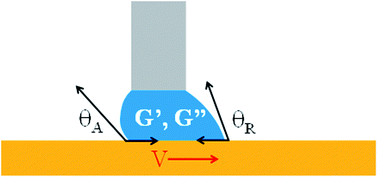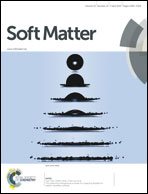Dynamic interfacial behavior of viscoelastic aqueous hyaluronic acid: effects of molecular weight, concentration and interfacial velocity†
Abstract
An aqueous hyaluronic acid (HA(aq)) pericellular coat, when mediating the tactile aspect of cellular contact inhibition, has three tasks: interface formation, mechanical signal transmission and interface separation. To quantify the interfacial adhesive behavior of HA(aq), we induce simultaneous interface formation and separation between HA(aq) and a model hydrophobic, hysteretic Si-SAM surface. While surface tension γ remains essentially constant, interface formation and separation depend greatly on concentration (5 ≤ C ≤ 30 mg mL−1), molecular weight (6 ≤ MW ≤ 2000 kDa) and interfacial velocity (0 ≤ V ≤ 3 mm s−1), each of which affect shear elastic and loss moduli G′ and G′′, respectively. Viscoelasticity dictates the mode of interfacial motion: wetting–dewetting, capillary necking, or rolling. Wetting–dewetting is quantified using advancing and receding contact angles θA and θR, and the hysteresis between them, yielding data landscapes for each C above the [MW, V] plane. The landscape sizes, shapes, and curvatures disclose the interplay, between surface tension and viscoelasticity, which governs interfacial dynamics. Gel point coordinates modulus G and angular frequency ω appear to predict wetting–dewetting (G < 75 ω0.2), capillary necking (75 ω0.2 < G < 200 ω0.075) or rolling (G > 200ω0.075). Dominantly dissipative HA(aq) sticks to itself and distorts irreversibly before separating, while dominantly elastic HA(aq) makes contact and separates with only minor, reversible distortion. We propose the dimensionless number (G′V)/(ωrγ), varying from ∼10−5 to ∼103 in this work, as a tool to predict the mode of interface formation-separation by relating interfacial kinetics with bulk viscoelasticity. Cellular contact inhibition may be thus aided or compromised by physiological or interventional shifts in [C, MW, V], and thus in (G′V)/(ωrγ), which affect both mechanotransduction and interfacial dynamics. These observations, understood in terms of physical properties, may be broadened to probe interfacial dynamics of other viscoelastic aqueous biopolymers.


 Please wait while we load your content...
Please wait while we load your content...